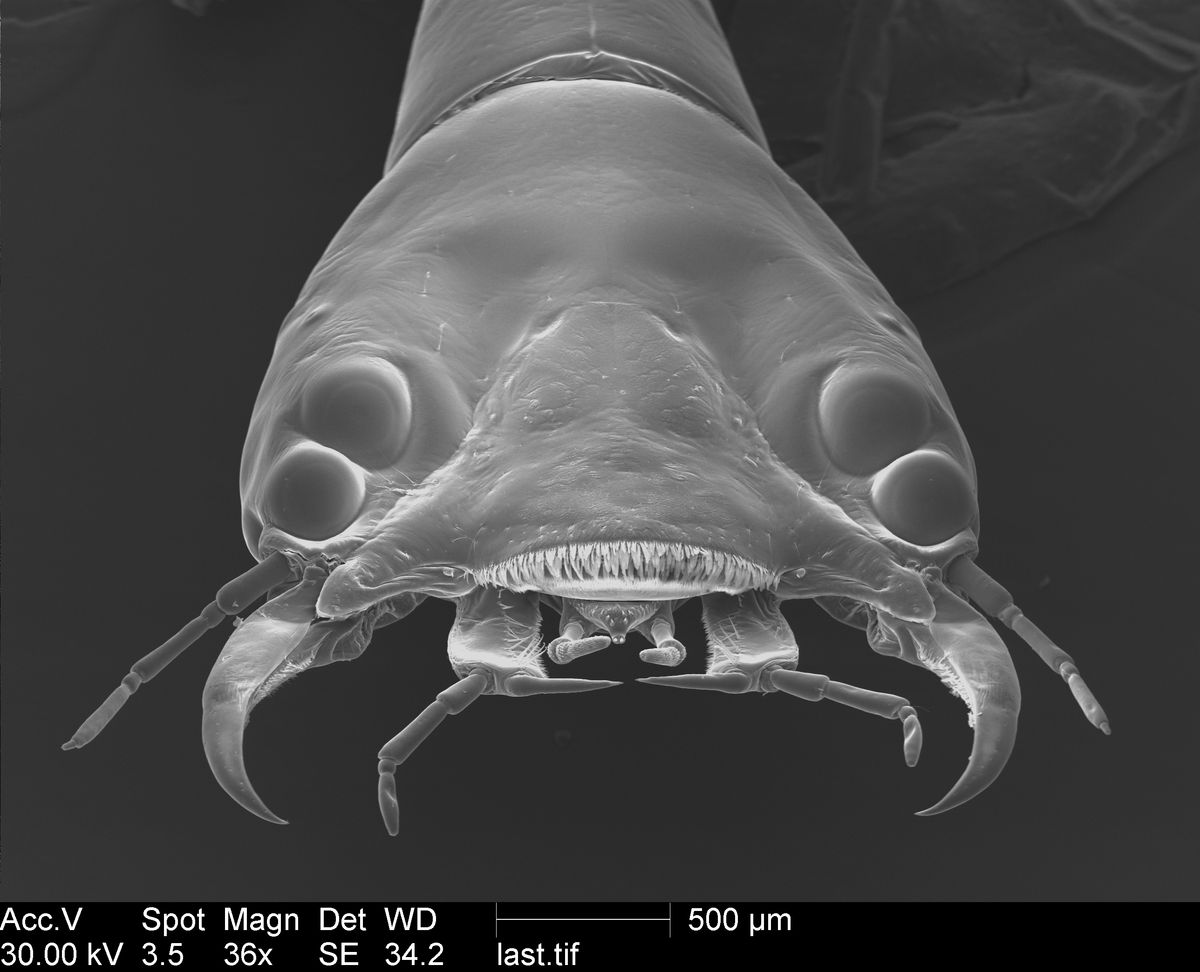Beetles Speed-Grow Their Built-In Bifocal Eyes

A diving beetle with highly complex eyes can grow its own bifocals at a surprisingly quick rate, scientists say. In a new study, the first to investigate how the beetles' unusual eyes develop, researchers discovered that all of the beetle's eye parts grew and changed rapidly when the larvae molted.
Sunburst diving beetles, also known as "water tigers," are efficient predators that depend on their eyes to help them nab their mosquito prey. And the larvae are as deadly as the adults, striking swiftly and suddenly at tadpoles and mosquito larvae, latching on with powerful mandibles, and sucking their hapless victims dry.
The larvae have their eyes to thank for their predatory success. They have two pairs of main eyes — large, forward-pointing tubular peepers — on both sides of their heads. Each tube holds a lens, cone and retina, which are features common to the image-forming eyes in most vertebrates (and some invertebrates) known as "camera eyes." In camera eyes, images enter the eye through the lens and are reflected onto the retina. [Video: Watch Juvenile Beetle Grab Mosquito Larva Lunch]
"Functionally, their eyes are more similar to our own eyes than to a fruit fly or other insect," Elke Buschbeck, a professor in the Department of Biological Sciences at the University of Cincinnati, and co-author of the new study, told Live Science. However, the larvae's eyes allow them to see only a narrow band of light, and they must move their heads up and down to "scan" whatever they're looking at.
Eye development is well studied in animals with backbones, but far less is known about how invertebrate camera eyes grow and change. And least understood of all were the particulars of how an invertebrate's camera-eye lens focuses on the retina, which is where Buschbeck and her colleagues turned their attention.
The speed of sight
In most invertebrates, eyes grow relatively slowly. But the beetle larvae's eyes transformed at a pace that the scientists found astonishing. The larvae experience three "instars" — developmental stages between molts — before reaching adulthood, with each stage lasting just a few days, the researchers said.
Sign up for the Live Science daily newsletter now
Get the world’s most fascinating discoveries delivered straight to your inbox.

Between the second and third stage, the eye tube grows dramatically, with all major changes happening within the first 60 minutes after molting. "As soon as we can measure it, it has already grown," Buschbeck said in a statement.
Because all the parts of camera eyes align so precisely, the larvae temporarily go blind when they molt, as the other eye parts race to catch up with the enlarged tubes. And that needs to happen quickly — a predator that can't see, is a predator that can't hunt.
To make things even more complicated, the lens in the larvae's eyes has built-in bifocals. Each eye tube holds not one, but two retinas, one slightly behind the other at the tube's bottom. The lens projects onto both retinas, allowing the larvae to see sharply focused images both up close and at a distance, at the same time.
The better to see you with
And yet, the larvae don't have long to wait. The researchers found that it takes only 8 hours for the lens to rebuild itself. Part of the old lens is shed with the old exoskeleton, and the remaining part expands, gaining diameter and thickness. Scientists projected through the lens, finding that it produced blurry images immediately after the molt, but that resolution and sharpness improved over the next few hours.
The scientists also observed that by the third day after molting, the larvae hunted three times as many mosquitoes as in the days immediately after molting, suggesting that their vision had been fully restored.
There is still more to discover about other factors that may contribute to the beetle larvae's rapid eye development. Osmosis — water absorption by the larvae while molting — could play a part, by increasing pressure in the eyes, which has been linked to eye growth in vertebrates. And, according to Buschbeck, there may be other aspects of the larvae's eye growth that align with what we know about vertebrate eyes.
The findings were published online Sept. 10 in the Journal of Comparative Physiology A.
Follow Mindy Weisberger on Twitter and Google+. Follow us @livescience, Facebook & Google+. Original article on Live Science.

Mindy Weisberger is an editor at Scholastic and a former Live Science channel editor and senior writer. She has reported on general science, covering climate change, paleontology, biology and space. Mindy studied film at Columbia University; prior to Live Science she produced, wrote and directed media for the American Museum of Natural History in New York City. Her videos about dinosaurs, astrophysics, biodiversity and evolution appear in museums and science centers worldwide, earning awards such as the CINE Golden Eagle and the Communicator Award of Excellence. Her writing has also appeared in Scientific American, The Washington Post and How It Works Magazine. Her book "Rise of the Zombie Bugs: The Surprising Science of Parasitic Mind Control" will be published in spring 2025 by Johns Hopkins University Press.











